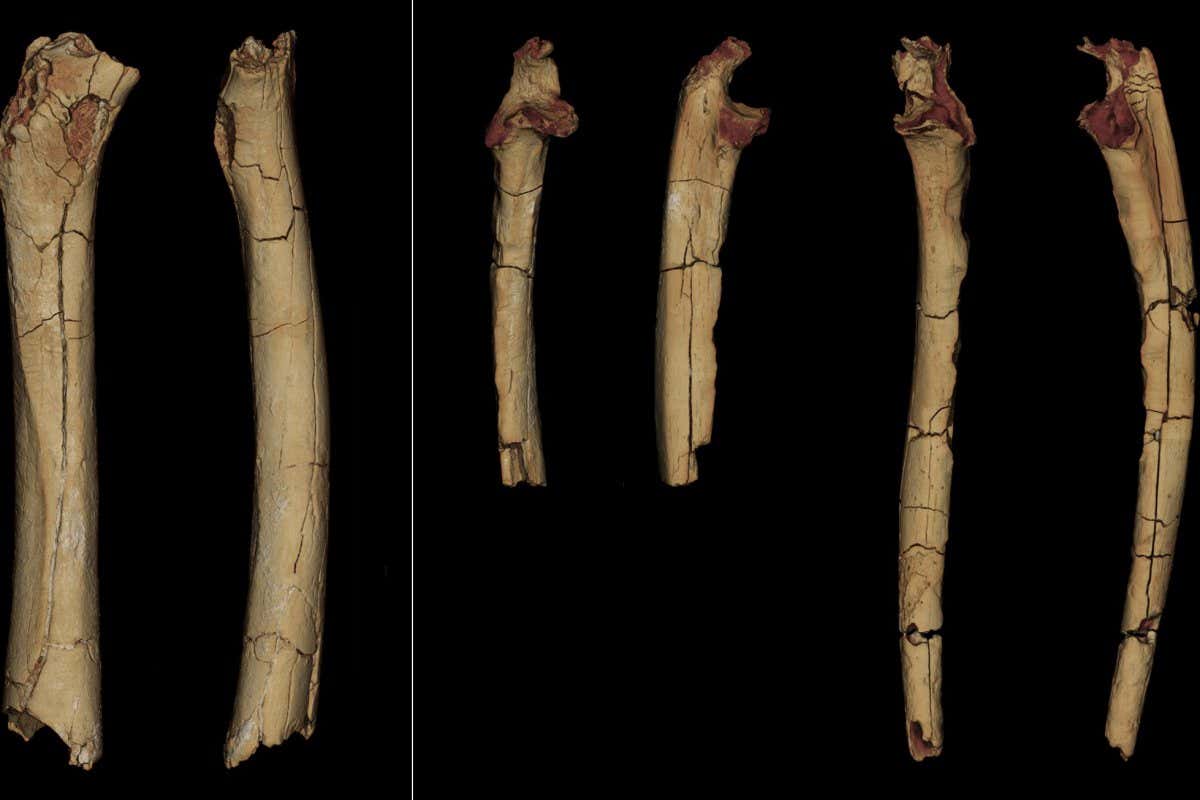An analysis of thigh and forearm bones from Sahelanthropus tchadensis suggests the early hominin was mainly bipedal, but the claim is controversial
Humans 24 August 2022
By Clare Wilson
3D models of the femur and ulnae of Sahelanthropus tchadensis
Franck Guy / PALEVOPRIM / CNRS – University of Poitiers
The ancestors of humans may have been walking on two legs by about 7 million years ago – a million years earlier than had been thought. But the finding, which comes from analysing a damaged thigh bone and two forearm bones, is controversial.
Estimates vary for when the ancestors of humans and chimpanzees split from each other but broadly converge on about 6 million years ago. This is also the age of the earliest fossil of a bipedal hominid, called Orrorin tugenensis.
The thigh bone, or femur, analysed in the latest study was discovered in the Lake Chad Basin in Chad. It was among thousands of bone pieces initially uncovered in 2001, almost all of which weren’t from primates.
Advertisement
The first hominin fossils identified among the bone pieces were fragments of skull and a few teeth. These were identified as a new and very early hominin species named Sahelanthropus tchadensis, dating from about 6 to 7 million years ago.
A later method of fossil dating, based on analysing different forms of the element beryllium, pushed the estimate further back to somewhere between 6.5 and 7.5 million years ago.
In 2004, a femur found among the bone pieces was identified as potentially belonging to a hominin by Aude Bergeret-Medina and Roberto Macchiarelli at the University of Poitiers in France. They later lost access to it, but in 2020 they published work based on measurements and photographs that argued that its shape suggests the owner didn’t walk on two legs.
Now, Franck Guy, who is also at the the University of Poitiers, and his colleagues, who still have access to the fossils, have published a full analysis of the femur as well as two forearm bones, including computed tomography scans to see their internal structure. It took so long partly because the team didn’t initially have the right expertise to analyse bones other than the skull, says Guy.
It is unknown if all the hominin bones came from the same individual or from several, but the researchers have assumed they belong to S. tchadensis as this was the only large primate with bones found at the site.
The researchers compared the S. tchadensis thigh and forearm bones with those from modern humans as well as chimpanzees, gorillas, orangutans and some extinct hominins and great apes. They conclude that S. tchadensis spent some time clambering in trees but usually walked on two legs, based on several features of the femur that they say are closer to those of modern humans than great apes that usually walk on four limbs. These include the distribution of thicker sections of the dense outer layer of bone, called the cortex, and the presence of a rough surface at the top of the femur where the buttock muscles attach.
“When on the ground they would have preferred to move bipedally. [When in trees] they would sometimes choose to use clambering. All the features point to this kind of behaviour,” says Guy.
But Macchiarelli isn’t convinced. This is partly because he says the angle the femur makes with the pelvis would be “mechanically unstable for a vertical stance”.
Other primates that mainly walk on four legs occasionally stand up and walk on two, which could be why S. tchadensis has some features of bipedalism, says Macchiarelli. “There’s a bipedal signal in any primate,” he says.
However, Guy says their conclusions are based not on individual aspects of the bone, but its overall suite of features.
Fred Spoor at the Natural History Museum in London says the authors “make a good case” for bipedalism, but that the debate is likely to continue. “Unless you have a time machine, you can’t go back and see for yourself,” he says.
The question is an important one because more recent hominins such as the australopiths both walked on two legs and climbed in trees as recently as 3 to 4 million years ago, he says. “That would mean that for the first 3 million years [of our history] there was this mixed locomotion, and not much was happening.”
Kelsey Pugh at the American Museum of Natural History in New York says it would be useful to compare the S. tchadensis femur with a wider range of living and extinct primates. “It will be vital for independent teams of palaeoanthropologists to study these exciting fossils in the coming months,” she says.
Journal reference: Nature, DOI: 10.1038/s41586-022-04901-z
Sign up to Our Human Story, a free monthly newsletter on the revolution in archaeology and human evolution
Article amended on 25 August 2022
We have corrected Macchiarelli’s view about the joint between the femur and the pelvis.
More on these topics:
































